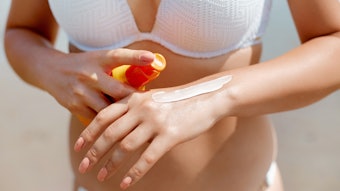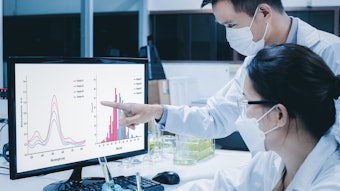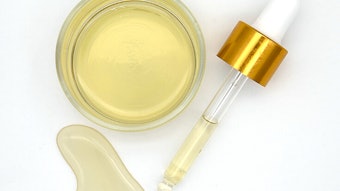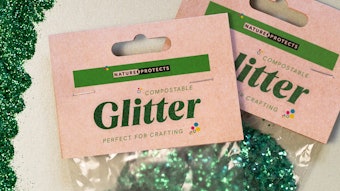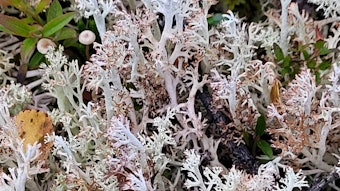Green chemistry in cosmetics is an ever-expanding area that has generated interest in the investigation of vegetal ingredients, environmentally friendly processes and by-products derived from other industrial applications, among others. For example, alpha-pinene is typically derived from pine trees but is also a by-product of the paper manufacturing process. Alpha-pinene is a source of low-toxic and naturally based non-ionic molecules such as isobornyl ethers.
From such isobornyl ethers, dipropylene glycol isobornyl ether was developed, a liquid hydrotrope characterized by an unusual lipid chain. The present study examines the properties of this material and its potential application in the cosmetic field. Materials such as these are of interest because they combine forthcoming chemical and physical properties with sustainability and other ecological aspects, thus paving the way to new product formulations.
Hydrotropes
Among the many ways to overcome the repulsion between lipid and aqueous phases in a formulation, the use of hydrotrope compounds is a well-known strategy in the cosmetic field.1 These materials are able to solubilize and form microemulsions of lipophilic materials in water, or vice versa. Hydrotropes are amphiphilic molecules where the lipophilic moiety is less prominent than in traditional surfactants.2 Therefore, the hydrophobic interactions are not strong enough to cause the auto-aggregation and formation of micelles or vesicles that occurs with surfactants.3
In addition, above a level called the minimum hydrotropic concentration, hydrotropes arrange themselves in ordered structures, similar to lamellar liquid crystals, that consist of alternating hydrophilic and hydrophobic regions. This structure is the basis of the solubilizing effect of hydrotropes and when a solute interacts with this system, it is stabilized.4
Typical hydrotropes widely used in chemical synthesis, mineral extraction and textiles include anionic benzoates and benzosulfonates, neutral phenols such as catechol and resorcinol, aliphatic glycol-sulphates and amino acids such as proline. Newer classes of hydrotropes have recently been developed for the cosmetics sector, including polypropylene, polyethylene glycol mono-alkyl ethers (PPE or PEE) and glycerol-1-monoethers, and these materials are characterized by short alkyl chains.
Dipropylene Glycol Isobornyl Ether
The hydrophobic chains of hydrotropes typically exhibit structural monotony; linear chains, -iso or Guerbet alcohols are the only other common alternatives, with the exception of the benzyl radical. However, as noted, a new liquid hydrotrope, dipropylene glycol isobornyl ethera, has been developed that is characterized by an unusual lipid chain (see Figure 1).5 In the present paper, this material will be referred to as DGIE.
DGIE is an ether of natural origin produced by combining dipropylene glycol with isoborneol or Borneo camphor, a bi-cyclic alcohol present in many plants that belong to the family of terpenes. The natural origin of the material suggests its environmental compatibility, which has been confirmed by degradation analysis revealing its partial mineralization by oxidation and hydrolysis, and leading to hydrophilic terpenes (data not shown).
The material is a transparent, slightly yellow liquid with a characteristic aromatic odor and good stability, evidenced by its molecular structure. It exhibits solubilizing and co-emulsifying properties, described below, although it is not classified as a surfactant according to the European Union (EU) regulation on detergents (EG 648/2004). Since DGIE is not an emulsifier but a hydrotrope, it is practically impossible to measure its hydrophilic-lipophilic balance (HLB) via standard methods. Indeed, addition of the material to water decreases the surface tension, nearly proportionally; from 62 mN/m at 20 mg/L to 45 mN/m at 120 mg/L. On the other hand, when DGIE is tested as an oil, it shows an apparent required HLB of 11.5 in the o/w region and a required HLB of 6.7 in the w/o region. In regard to safety, tests have verified its low toxicity (LD50 > 2000 mg/kg); in addition, it has not been found to cause irritation at use percentages below 10% or sensitization, and it is non-mutagenic.6
Besides these attributes, the authors further evaluated the material’s compatibility with ingredients commonly used in cosmetics, e.g. water, glycols, alcohols, oils and waxes; and its ability to solubilize sparingly soluble compounds such as sunscreens, extracts and perfumes. In addition, its ability to disperse pigments and act as a co-emulsifier were examined. Finally, the influence of the material on key sensorial characteristics of formulae were evaluated by a panel of experts to provide qualitative information.
Compatibility
The compatibility of DGIE with various ingredients was evaluated by mixing it 1:1 with water, glycerol, ethanol and oils with different polarity, including hydrogenated polydecene, isododecane, C12-15 alkyl benzoate, caprylic/capric triglyceride, isostearyl alcohol, isostearic acid, cyclopentasiloxane, dimethicone 1000, and sweet almond and castor oils. The resulting mixtures were examined visually, both immediately and 24 hr after preparation. Furthermore, the sensorial characteristics of the mixtures were compared to pure oils by a panel of experts.
The parameters considered were spreadability, absorption velocity, oiliness and shine. The solubility of DGIE in water was 154 mg/L at room temperature. In glycerol, the blend was initially homogenous but became stratified after 24 hr. The material was completely miscible with ethanol as well as all oils, regardless of their polarity, and the volatile silicone. The only exception noted was with dimethicone 1000.
When combined with the oils, DGIE did not influence their sensorial characteristics significantly. The perception of oiliness was slightly decreased and the spreadability increased only with greasy oils such as high molecular weight hydrogenated polydecene, sweet almond and castor oil.
The compatibility of the material with different waxes also was evaluated by melting two parts wax at 85°C with eight parts DGIE. The mixture was then cooled slowly while homogenizing, in order to avoid crystallization. The ingredient was found (see Figure 2) to be compatible with beeswax, rice bran wax, microcrystalline wax and ozokerite, and all were found to have a good thickening effect on DGIE, significantly reducing their waxy, heavy perception on skin thus forming pleasant lipo-gel structures with low oiliness and shine. These properties could be exploited to prepare protective hand creams.
Solubility
The solubility of commonly difficult-to-dissolve ingredients in DGIE was evaluated by preparing solutions at different concentrations and storing them both at 4°C and room temperature, then observing their transparency 48 hr later when brought back to room temperature. The compounds tested included: butyl methoxy dibenzoylmethane, glycyrrhetinic acid, salicylic acid, biotin, quercetin, menthol, Boswellia serrata and Rosmarinus officinalis dry extract. The solutions were prepared by heating and mixing them until complete dissolution, then cooling to room temperature while mixing.
DGIE dissolved glycyrrhetinic acid at a concentration of up to 3%, notably 30 times greater than other oils; salicylic acid—in clear solutions, up to 10%, and in opalescent stable solutions up to 16%; Boswellia serrata dry extract with three parts DGIE; menthol with two parts DGIE; and quercetin at 0.03%. The material’s solvent power was moderate toward the UVA sunscreen butyl methoxydibenzoylmethane, which was soluble at 6.5% in this case. Further, DGIE at 10% and 15% was added to an opalescent bath oil containing typically incompatible ingredients (see Formula 1). The material was used to replace hydrogenated polydecene and at 15%, it provided a completely transparent formula (see Figure 3).
Dispersion of Aluminium Chlorohydrate
Aluminium chlorohydrate was dispersed in DGIE at 10%, 20% and 50% and the sensorial characteristics of the mixtures were evaluated. In addition, an antiperspirant spray was formulated both with and without the material (see Formula 2), where the DGIE replaced dicaprylyl ether, and both formulas were compared by a panel of sensory experts. The parameters considered were absorption velocity, oiliness, stickiness and final residue.
Although the material was unable to dissolve the aluminium chlorohydrate, it was able to disperse it even at a high concentration and provided a pleasant, non-oily and velvety feel. In addition, neither stickiness nor heavy residue, which are peculiar to aqueous solutions of this salt, were evidenced. The antiperspirant deodorant formula containing 5% DGIE and 15% aluminium chlorohydrate was less sticky in the spreading phase, and had, after qualitative evaluation, a lighter and more pleasant after-feel than the reference formula containing dicaprylyl ether.
Pigment Dispersion
Titanium dioxide (CI 77891), iron oxides (CI 77491, CI 77492, CI 77499), a lake (CI 15850) and zinc oxide were dispersed in DGIE with a turbine at increasing concentrations until a maximum amount was reached while retaining smooth, homogeneous dispersions. Titanium dioxide and iron oxides were dispersed up to 65%, zinc oxide up to 70% and the lake up to 45%—almost double the amounts achievable by castor oil, the most commonly used dispersant (data not shown). DGIE was then added at 5% and 10% to a lipstick base containing 8% pigments, 41% castor oil, 20% waxes and other oils and pasty ingredients. Spreadability, shine and homogeneity of the trace were evaluated by a panel of experts and all parameters showed improvements with the addition of DGIE at both concentrations (data not shown).
Influence on Fixative Polymers
Hair spray containing 2.5% and 5% of fixative polymers such as VP/VA copolymer and vinylcaprolactam/VP/dimethylaminoethyl methacrylate copolymer were prepared by dissolving the polymers in water, ethanol and isopropyl alcohol; the same formulas were then prepared by replacing the isopropyl alcohol with 2.5%, 5% and 10% of DGIE (see Formula 3). The same amounts of the sample formulas were also sprayed on brown and red hair tresses.
After 48 hr, the shine and fixative effect were evaluated by a panel of experts. When added to hydroalcoholic hair spray at concentrations between 3% and 5%, DGIE was found sensorially to improve the adhesion of polymers to the hair significantly, thus increasing the fixative effect. This advantage not only improved hold, but also kept the polymers content low. The solvent effect of DGIE was less aggressive and degreasing, compared with isopropyl alcohol; moreover, it imparted a less dry feel to the hair. Alcohols are aggressive and degreasing, therefore replacing them with DGIE would reduce these sensations.
Co-emulsifying Properties
Finally, the co-emulsifying properties of DGIE were evaluated by adding 3% or 5% of the material to the oily phase of several typically unstable test formulas (see Formula 4). After emulsification, the o/w and w/o emulsions were observed using a microscope and tested via centrifuge (7,000 g at 35°C for 30 min). In addition, the emulsions obtained were sensorially evaluated by a panel of experts who considered spreadability, absorption velocity, oiliness and shine. Moreover, the influence of DGIE on the whitening effect of w/o sunscreens containing coated titanium dioxide and zinc oxide was evaluated.
No interesting results were observed with o/w emulsions; however, DGIE showed good results in w/o systems. The standard w/o emulsion that became stratified immediately was stabilized both with 3% and 5% DGIE. At 3%, the material did not modify the formula’s sensorial characteristics, whereas the spreadability, emollient feel and velocity of absorption of test formulas were slightly increased with a 5% concentration. In addition, the authors interestingly observed a reduced whitening effect in a sunscreen formula containing titanium dioxide and zinc oxide during spreading (data not shown).
Conclusions
The systematic study described here revealed several interesting properties. First, DGIE proved to be a good solubilizing agent in aqueous or oily mediums and a good co-emulsifier in w/o emulsions, where it also reduced the whitening effect of physical sunscreens. The material also improved the sensorial characteristics of aluminium chlorohydrate-containing products, and was a good dispersant for pigments, imparting shine and homogeneity to the trace of lip products.
In addition, DGIE increased the performance of fixative polymers, thus reducing the amount of polymers required as well as the dry feel caused by solvents. Finally, the material could potentially improve the efficiency of active ingredients by increasing their solubility and bioavailability.
In the end, it was therefore worth exploring this naturally derived material, especially during a time of increased interest in renewable sources—and since unexpected synergies were exploited. All the described properties could lead to better performing cosmetics by reducing formula costs, improving sensory characteristics and/or improving the compatibility among several ingredients in surfactant systems.
References
Send e-mail to [email protected].
- KH Raney and CA Miller, Optimum detergency conditions with nonionic surfactants: Effect of hydrophobic additives, J Colloid Interface Sci 119 539–549 (1987)
- C Neuberg, Hydrotropy, Biochem Z 76 107–108 (1916)
- V Srinivas and D Balasubramanian, When does the switch from hydrotropy to micellar behavior occur? Langmuir 14 6658–6661 (1998)
- V Srinivas, GA Rodley, K Ravikumar, WT Robinson, MM Turnbull and D Balasubramanian, Molecular organization in hydrotrope assemblies, Langmuir 13 3235–3239 (1997)
- Patent 0943599-B1 and DE 19812245, assigned to CABB (Nov 3, 1999)
- E Schnell, D Touraud, R Gick and W Kunz, Properties of a new hydrotrope hydrophobic molecule and its potential applications, Int J of Cosm Sci 30 347–351 (2008)
